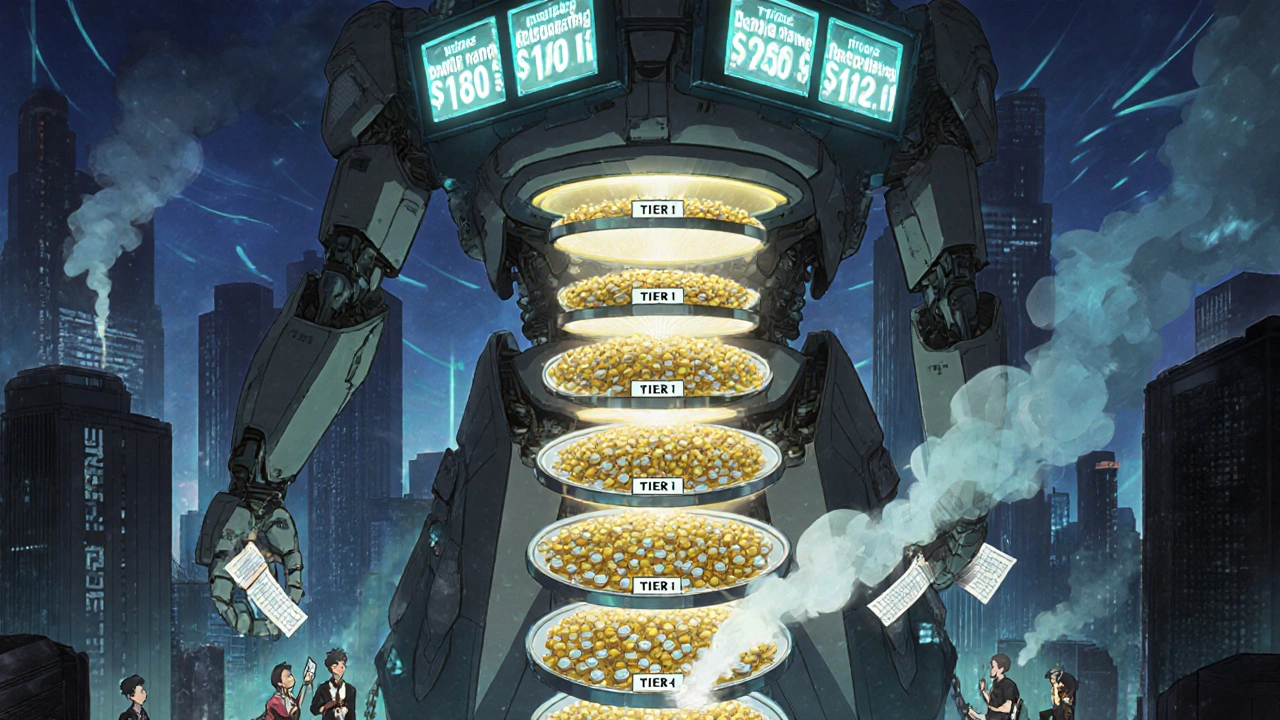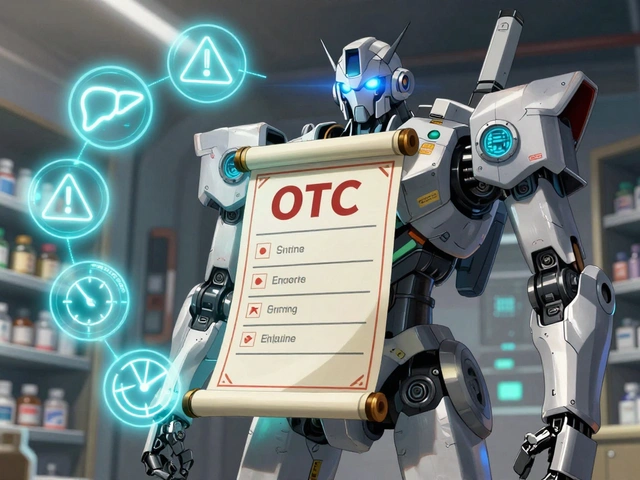When you pick up a prescription at the pharmacy, you might not realize that the drug you’re given wasn’t chosen just by your doctor - it was also filtered through a hidden system called a preferred generic list. These lists, built by insurance companies and their pharmacy benefit managers (PBMs), decide which drugs are cheapest for you to take - and which ones you’ll have to fight for. It’s not about preference. It’s about control. And it’s happening in almost every health plan in the U.S.
How Preferred Generic Lists Work
Insurers don’t just cover any drug that’s FDA-approved. They organize medications into tiers, like levels in a pricing game. Tier 1 is where you’ll find preferred generics - the same active ingredients as brand-name drugs, but priced at 80-85% less. For example, a 30-day supply of levothyroxine (a thyroid hormone) might cost $187 as a brand, but just $12 as a generic. That’s not a coincidence. It’s by design.
These lists are managed by Pharmacy Benefit Managers - big companies like CVS Health, Cigna’s Evernorth, and UnitedHealth’s OptumRx - who control 78% of the market. They negotiate directly with drug makers, squeezing prices down. When a generic has six or more competitors, prices can drop by up to 95%. That’s why insurers push them hard. In 2023, 90% of all prescriptions filled in the U.S. were generics, but they made up only 23% of total drug spending.
The tier system usually looks like this:
- Tier 1: Preferred generics - $5 to $15 copay
- Tier 2: Preferred brand-name or higher-cost generics - $25 to $50 copay
- Tier 3: Non-preferred brands - $50 to $100 copay
- Tier 4: Specialty drugs (like biologics) - $100+ or coinsurance
Medicare Part D plans and nearly all commercial insurers use this structure. In fact, 92% of Medicare plans use four tiers. The goal? Get you to the cheapest option that still works.
Why Insurers Push Generics - And Why It Works
It’s simple math. Generic drugs must meet the FDA’s strict bioequivalence standards: they must deliver the same amount of active ingredient into your bloodstream as the brand, within 80-125% of the original. The FDA confirmed in 2021 that 98.5% of generic approvals meet this standard. That means, for most people, a generic isn’t just cheaper - it’s just as effective.
When insurers put generics in Tier 1, they’re not just saving money for themselves. They’re saving you too. A 2022 study showed that for every brand-name prescription replaced with a generic, patients saved an average of $194 per fill. For chronic conditions like high blood pressure or cholesterol, that adds up fast. A statin like atorvastatin (Lipitor) might cost $150 a month as a brand, but under $10 as a generic. That’s $1,680 a year saved - per person.
And it’s not just individuals. The entire U.S. healthcare system saves $1.68 trillion annually thanks to generic substitution, according to a 2023 Harvard Medical School study. That’s more than the annual GDP of most countries.
Where the System Falls Short
But not all drugs are created equal - and not all patients benefit equally.
Take biosimilars. These are generic versions of complex biologic drugs like Humira or Enbrel. They’re cheaper, but insurers don’t always make them easy to access. While 90% of regular generics are used in the U.S., only 15% of eligible biologic prescriptions switch to biosimilars. Why? Because brand-name manufacturers offer co-pay assistance cards that cut patient costs to $5 or $10 a month. Biosimilar makers can’t - and insurers won’t cover the gap. So a patient might pay $850 for a biosimilar, but $1,200 for Humira - and still end up paying more out of pocket because their co-pay card disappeared.
Then there’s the issue of narrow-therapeutic-index drugs. These are medications where even small changes in dosage can cause serious side effects - like warfarin (a blood thinner) or lithium. A 2022 study by the American College of Clinical Pharmacy found that 23% of doctors refuse to switch patients to generics for these drugs, fearing instability. Insurers don’t always respect that. Many still require patients to try the generic first - even when the doctor says no.
That’s where “step therapy” comes in. It’s a policy that forces you to try the cheapest drug before moving up. The American Medical Association reported in 2022 that 42% of doctors saw delays in treatment for chronic pain patients because insurers made them fail on preferred generics first. One patient might need a specific brand because they’re allergic to a filler in the generic. But unless the doctor files a prior authorization - and it gets approved - you’re stuck.

What Patients Don’t Know (And Why It Costs Them)
Most people have no idea how their formulary works. A 2023 Medicare survey found that 58% of enrollees couldn’t name their plan’s tier structure. That leads to surprises at the pharmacy counter. One patient expects a $10 copay, only to be told their drug moved to Tier 3 and now costs $75. That’s not a glitch - it’s policy.
GoodRx’s 2023 survey of 15,000 patients showed that 63% had at least one prescription denied or delayed because it wasn’t on the preferred list. And 44% of patients on biologics reported trouble switching to biosimilars because their manufacturer’s co-pay help vanished.
Even when generics are available, pharmacists can’t always swap them automatically. In 89% of states, pharmacists can substitute a generic unless the doctor writes “dispense as written.” But 37% of patients don’t even know this option exists. So they accept the brand, pay more, and never question it.
How to Navigate the System
You don’t have to be powerless. Here’s what actually works:
- Check your formulary every year. During open enrollment, look up your medications on your insurer’s website. If your drug moved up a tier, you could pay hundreds more next year.
- Ask your pharmacist. They know which generics are preferred. If your doctor prescribes a brand, ask: “Is there a generic on Tier 1?”
- Request prior authorization. If your doctor says you need a non-preferred drug, they can file an appeal. Kaiser Family Foundation data shows 68% of these appeals succeed - if they include medical justification.
- Use tools like Medicare’s Plan Finder. It scores 4.2/5 for usability. Commercial plans? They average 2.8/5. Don’t trust them.
- Know your out-of-pocket cap. Starting in 2025, Medicare Part D will cap annual drug costs at $2,000. But beware: some PBMs now use “accumulator adjuster” programs that don’t count biosimilar costs toward your cap. That means you pay more even if you’re using the cheaper drug.
Patients who spend just 45 minutes a year reviewing their formulary save an average of 32% on medication costs - that’s over $400 per drug annually, according to SmithRx.

The Future of Formularies
The system is changing. In 2024, CMS required all Medicare plans to publicly explain how they assign tiers. UnitedHealthcare rolled out “Value-Based Formularies” that move drugs up or down based on real-world outcomes - not just price. And starting in 2025, Medicare will require biosimilars to be placed in the same tier as their brand-name counterparts, which could boost usage from 15% to 45%.
But the biggest shift may come from data. McKinsey predicts that by 2030, tier placement won’t just be about cost - it’ll be about results. Which drug actually keeps patients out of the hospital? Which one leads to fewer side effects? Those will be the winners.
For now, the system is still built on cost control. And while it saves billions and helps millions, it also creates barriers - especially for those with complex conditions or limited access to care.
Understanding your formulary isn’t just about saving money. It’s about making sure your treatment isn’t dictated by a spreadsheet.
Why do insurance companies prefer generic drugs?
Insurers prefer generic drugs because they cost 80-85% less than brand-name versions, with some generics dropping up to 95% in price when multiple manufacturers compete. By placing generics in Tier 1 of their formularies, insurers reduce overall drug spending, lower premiums, and cut out-of-pocket costs for members - while still delivering the same active ingredients under FDA bioequivalence standards.
Are generic drugs really as effective as brand-name drugs?
Yes, for most people. The FDA requires generics to deliver the same amount of active ingredient into the bloodstream as the brand, within a narrow 80-125% range. Studies show 98.5% of approved generics meet this standard. For common conditions like high blood pressure, cholesterol, or thyroid disorders, generics work just as well. Exceptions exist for narrow-therapeutic-index drugs like warfarin, where some doctors avoid switching due to stability concerns.
What’s the difference between a preferred generic and a non-preferred generic?
A preferred generic is on Tier 1 of your insurance formulary and has the lowest copay - usually $5-$15. A non-preferred generic may be chemically identical but isn’t negotiated for the best price by your insurer’s pharmacy benefit manager (PBM). It’s often placed in Tier 2 or higher, meaning you pay more. This isn’t about quality - it’s about contracts and rebates.
Can I still get my brand-name drug if it’s not on the preferred list?
Yes - but it’s harder. Your doctor can request a prior authorization, explaining why the generic won’t work for you - maybe due to allergies, side effects, or a history of instability. If they provide strong medical justification, insurers approve the request 68% of the time. You can also appeal if it’s denied.
Why are biosimilars harder to get than regular generics?
Biosimilars are cheaper versions of complex biologic drugs, but they face two big barriers: First, brand-name manufacturers offer co-pay cards that reduce patient costs to near zero - biosimilar makers can’t match that. Second, many insurers don’t place biosimilars in the same tier as the brand, so patients pay more out of pocket. Starting in 2025, Medicare will require them to be on the same tier, which should improve access.
How can I find out which drugs are on my plan’s preferred list?
Log in to your insurer’s website and look for your plan’s formulary or preferred drug list. Medicare beneficiaries can use the Plan Finder tool (medicare.gov/plan-compare). Commercial plans vary in usability - many are hard to navigate. If you can’t find it, call customer service and ask for the current formulary document. Check it every year during open enrollment.
Do pharmacists automatically substitute generics?
In 89% of U.S. states, pharmacists can substitute a generic for a brand-name drug unless the doctor writes “dispense as written.” But 37% of patients don’t know this - so they accept the brand and pay more. Always ask your pharmacist: “Can I get the generic version?” - even if your doctor didn’t prescribe it.
What to Do Next
Don’t wait for a surprise at the pharmacy. Take 45 minutes this month to:
- Check your plan’s formulary online
- Write down your top three medications and their current tier
- Ask your doctor: “Is there a preferred generic for this?”
- Call your pharmacist and ask if they can switch your prescription automatically
If your drug moved up a tier this year, you could be paying hundreds more. That’s not just a cost increase - it’s a risk to your health. When people skip doses because of price, hospitalizations go up. Formularies save money - but only if you know how to use them.





Malia Blom
November 9, 2025 AT 03:24So let me get this straight - we’re celebrating cost-cutting as if it’s a moral victory, but ignoring that people are skipping doses because they can’t afford the $75 version that’s ‘not preferred’? This isn’t healthcare, it’s a spreadsheet with a stethoscope. You think a diabetic on insulin is thinking about ‘bioequivalence’ when they’re choosing between food and their meds? The system doesn’t care if you live - it just wants your copay to be under $15. 🤡
Erika Puhan
November 10, 2025 AT 05:30It’s fascinating how the PBM-industrial complex has weaponized pharmacoeconomics to the point where therapeutic equivalence is now a negotiable metric. The structural asymmetry between branded biologics and biosimilars isn’t a market failure - it’s a regulatory capture masquerading as cost containment. The FDA’s 80-125% bioequivalence window? That’s not science - it’s a loophole dressed in white coats. And don’t even get me started on accumulator adjusters. Those are pure rent-seeking behavior disguised as ‘innovation.’
Edward Weaver
November 10, 2025 AT 09:07Look, I get it - you’re mad because your $1,200 Humira got swapped for a $850 biosimilar. But here’s the thing: America spends more on healthcare than the next 10 countries combined. If you want to keep paying $150 for a statin when the generic costs $10, fine - but don’t cry when your premiums go up. We’re not Europe. We don’t have socialized medicine because we don’t want it. If you want cheaper drugs, stop demanding brand-name crap and get with the program. This isn’t about ‘control’ - it’s about common sense.
Lexi Brinkley
November 10, 2025 AT 20:33OMG YES 😭 I just got hit with a $90 copay for my blood pressure med and I thought I was gonna cry. I asked my pharmacist and she was like ‘Oh, it moved to Tier 3 last month.’ I had NO IDEA. I’m gonna check my formulary tonight and scream into the void. Also, why do they make these websites look like they were coded in 2003?? 💀
Kelsey Veg
November 12, 2025 AT 13:29so like… generics are just as good right? but then why do i feel weird when i switch? like my anxiety got worse? or was it the filler? idk but my doc said ‘it’s the same chem’ but i swear i feel different. also why does my pill look like a tiny rainbow now?? 🤔
Alex Harrison
November 12, 2025 AT 13:33Just wanted to say that prior auths are way easier than people think. My mom had to get one for her antidepressant last year - doctor filled out the form, sent it in, and it was approved in 3 days. She didn’t even have to call. The hard part is getting your doctor to care enough to do it. If they’re lazy, find a new one. And yes, ask your pharmacist. They’re the real MVPs.
Jay Wallace
November 14, 2025 AT 09:47Let’s be clear: The U.S. healthcare system is not broken - it’s operating exactly as designed. PBMs are not villains; they’re market optimizers. The fact that 90% of prescriptions are generics? That’s not coercion - that’s efficiency. And anyone who claims they ‘can’t tolerate’ a generic? Probably just wants the brand because they think it’s ‘better.’ Newsflash: It’s not. You’re not special. The FDA doesn’t care about your feelings. And if you can’t afford $10 a month? Maybe you shouldn’t be on a $150 drug in the first place.
Alyssa Fisher
November 14, 2025 AT 17:26I’ve been thinking a lot about this lately - not just as a patient, but as someone who’s watched a parent struggle with chronic illness. The real tragedy isn’t the cost of drugs. It’s the silence around them. We talk about cancer treatments, but not about the 70-year-old who skips her blood pressure pills because the copay jumped from $5 to $50. We call it ‘formulary management.’ It’s really just rationing by bureaucracy. And the worst part? We’ve normalized it. We scroll past it like it’s just another ad. But it’s not. It’s life. And if we’re going to call this ‘healthcare,’ then we owe it to each other to stop pretending it’s fair.
Alyssa Salazar
November 15, 2025 AT 11:08Okay, but let’s talk about the PBM rebate system - it’s the elephant in the room nobody names. Insurers don’t save money because generics are cheap - they save because the PBM gets a kickback from the brand-name maker for pushing the expensive drug. Wait, what? Yeah. The ‘preferred’ generic? Often the one that pays the PBM the lowest rebate. The non-preferred brand? The one with the fat rebate. So the system is literally incentivized to make you pay more. This isn’t about cost control - it’s about hidden profits. And we’re all paying for it. 🤯
Beth Banham
November 17, 2025 AT 01:14Thanks for writing this. I didn’t know where to start, but I’m checking my formulary this week. I’ve been on the same med for 8 years and never thought to look. I’ll ask my pharmacist next time. Small steps, right? 😊